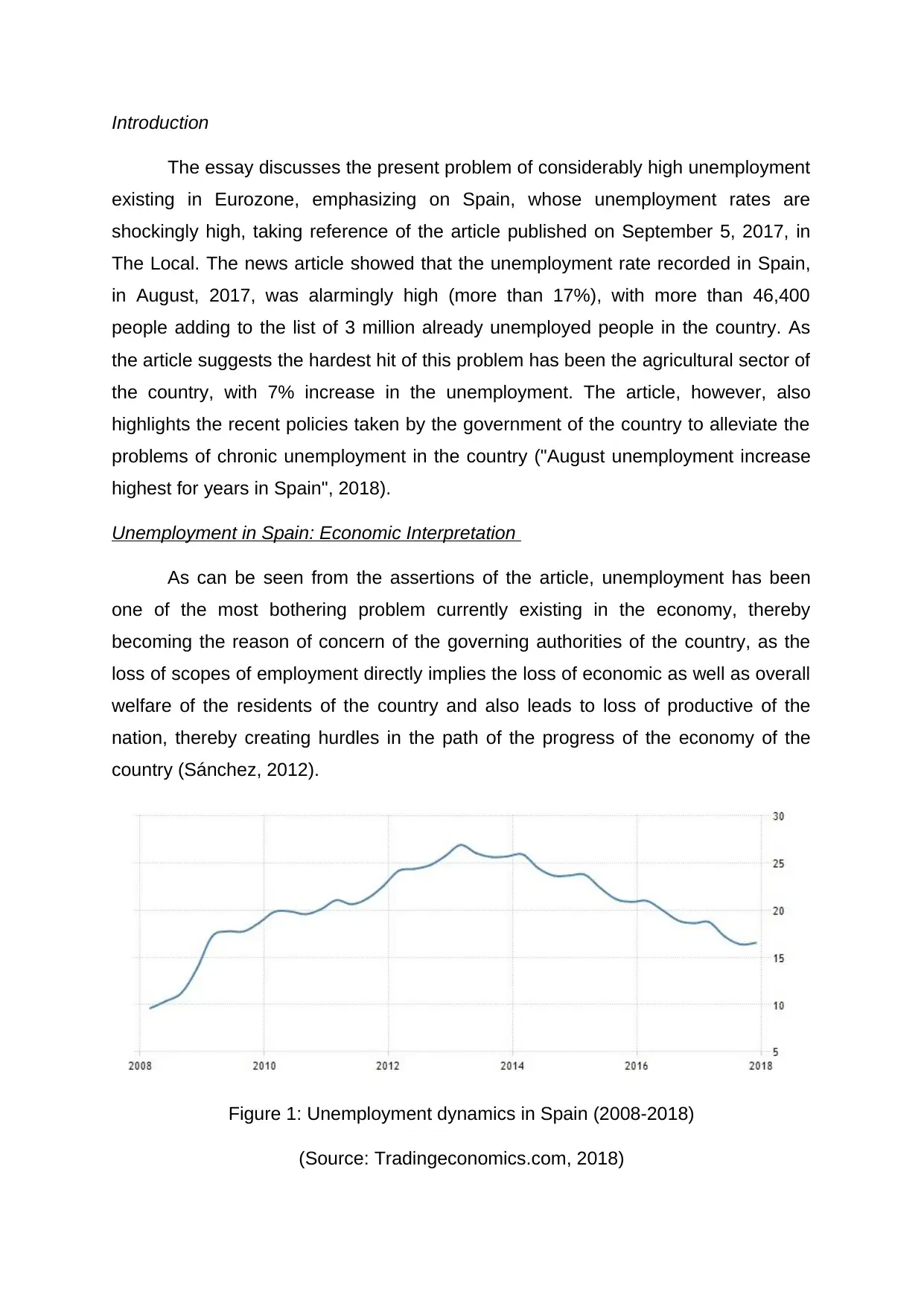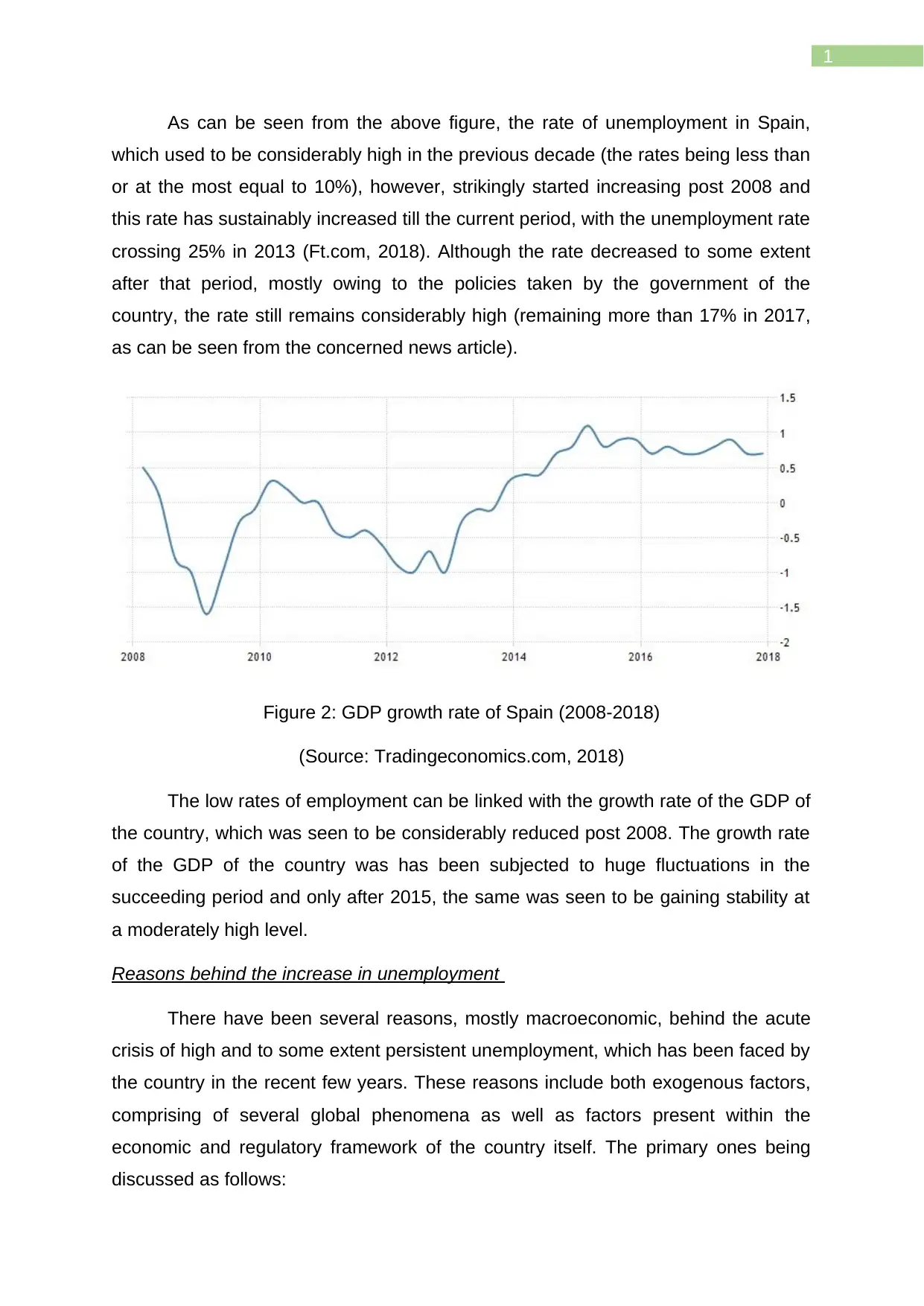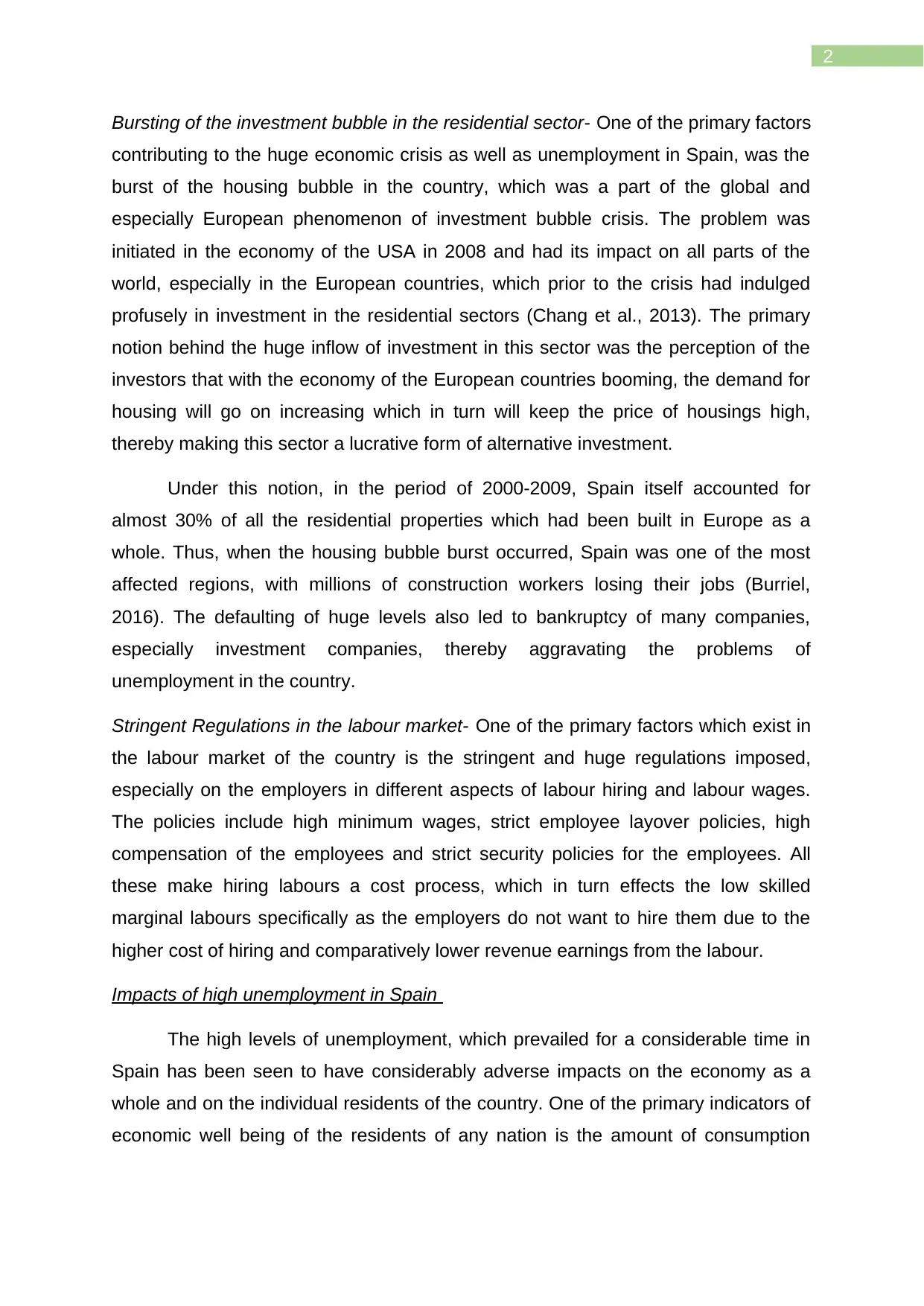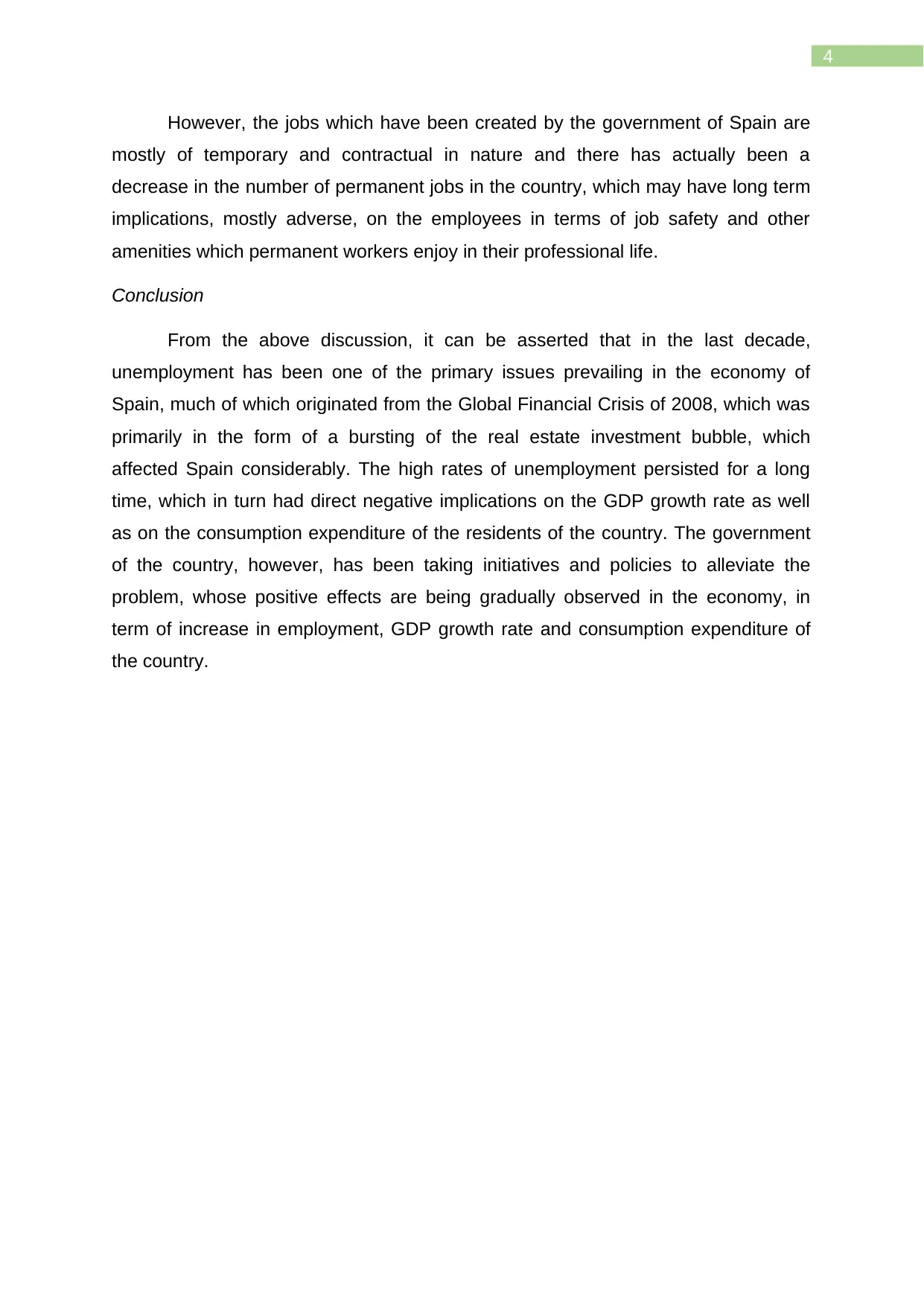Unemployment in Spain: Causes, Impacts and Government Policies
VerifiedAdded on 2023/06/15
|7
|1855
|407
AI Summary
The essay discusses the present problem of considerably high unemployment existing in Eurozone, emphasizing on Spain, whose unemployment rates are shockingly high. It discusses the reasons behind the increase in unemployment, its impacts and government policies to combat the situation.
Contribute Materials
Your contribution can guide someone’s learning journey. Share your
documents today.

Introduction
The essay discusses the present problem of considerably high unemployment
existing in Eurozone, emphasizing on Spain, whose unemployment rates are
shockingly high, taking reference of the article published on September 5, 2017, in
The Local. The news article showed that the unemployment rate recorded in Spain,
in August, 2017, was alarmingly high (more than 17%), with more than 46,400
people adding to the list of 3 million already unemployed people in the country. As
the article suggests the hardest hit of this problem has been the agricultural sector of
the country, with 7% increase in the unemployment. The article, however, also
highlights the recent policies taken by the government of the country to alleviate the
problems of chronic unemployment in the country ("August unemployment increase
highest for years in Spain", 2018).
Unemployment in Spain: Economic Interpretation
As can be seen from the assertions of the article, unemployment has been
one of the most bothering problem currently existing in the economy, thereby
becoming the reason of concern of the governing authorities of the country, as the
loss of scopes of employment directly implies the loss of economic as well as overall
welfare of the residents of the country and also leads to loss of productive of the
nation, thereby creating hurdles in the path of the progress of the economy of the
country (Sánchez, 2012).
Figure 1: Unemployment dynamics in Spain (2008-2018)
(Source: Tradingeconomics.com, 2018)
The essay discusses the present problem of considerably high unemployment
existing in Eurozone, emphasizing on Spain, whose unemployment rates are
shockingly high, taking reference of the article published on September 5, 2017, in
The Local. The news article showed that the unemployment rate recorded in Spain,
in August, 2017, was alarmingly high (more than 17%), with more than 46,400
people adding to the list of 3 million already unemployed people in the country. As
the article suggests the hardest hit of this problem has been the agricultural sector of
the country, with 7% increase in the unemployment. The article, however, also
highlights the recent policies taken by the government of the country to alleviate the
problems of chronic unemployment in the country ("August unemployment increase
highest for years in Spain", 2018).
Unemployment in Spain: Economic Interpretation
As can be seen from the assertions of the article, unemployment has been
one of the most bothering problem currently existing in the economy, thereby
becoming the reason of concern of the governing authorities of the country, as the
loss of scopes of employment directly implies the loss of economic as well as overall
welfare of the residents of the country and also leads to loss of productive of the
nation, thereby creating hurdles in the path of the progress of the economy of the
country (Sánchez, 2012).
Figure 1: Unemployment dynamics in Spain (2008-2018)
(Source: Tradingeconomics.com, 2018)
Secure Best Marks with AI Grader
Need help grading? Try our AI Grader for instant feedback on your assignments.

1
As can be seen from the above figure, the rate of unemployment in Spain,
which used to be considerably high in the previous decade (the rates being less than
or at the most equal to 10%), however, strikingly started increasing post 2008 and
this rate has sustainably increased till the current period, with the unemployment rate
crossing 25% in 2013 (Ft.com, 2018). Although the rate decreased to some extent
after that period, mostly owing to the policies taken by the government of the
country, the rate still remains considerably high (remaining more than 17% in 2017,
as can be seen from the concerned news article).
Figure 2: GDP growth rate of Spain (2008-2018)
(Source: Tradingeconomics.com, 2018)
The low rates of employment can be linked with the growth rate of the GDP of
the country, which was seen to be considerably reduced post 2008. The growth rate
of the GDP of the country was has been subjected to huge fluctuations in the
succeeding period and only after 2015, the same was seen to be gaining stability at
a moderately high level.
Reasons behind the increase in unemployment
There have been several reasons, mostly macroeconomic, behind the acute
crisis of high and to some extent persistent unemployment, which has been faced by
the country in the recent few years. These reasons include both exogenous factors,
comprising of several global phenomena as well as factors present within the
economic and regulatory framework of the country itself. The primary ones being
discussed as follows:
As can be seen from the above figure, the rate of unemployment in Spain,
which used to be considerably high in the previous decade (the rates being less than
or at the most equal to 10%), however, strikingly started increasing post 2008 and
this rate has sustainably increased till the current period, with the unemployment rate
crossing 25% in 2013 (Ft.com, 2018). Although the rate decreased to some extent
after that period, mostly owing to the policies taken by the government of the
country, the rate still remains considerably high (remaining more than 17% in 2017,
as can be seen from the concerned news article).
Figure 2: GDP growth rate of Spain (2008-2018)
(Source: Tradingeconomics.com, 2018)
The low rates of employment can be linked with the growth rate of the GDP of
the country, which was seen to be considerably reduced post 2008. The growth rate
of the GDP of the country was has been subjected to huge fluctuations in the
succeeding period and only after 2015, the same was seen to be gaining stability at
a moderately high level.
Reasons behind the increase in unemployment
There have been several reasons, mostly macroeconomic, behind the acute
crisis of high and to some extent persistent unemployment, which has been faced by
the country in the recent few years. These reasons include both exogenous factors,
comprising of several global phenomena as well as factors present within the
economic and regulatory framework of the country itself. The primary ones being
discussed as follows:

2
Bursting of the investment bubble in the residential sector- One of the primary factors
contributing to the huge economic crisis as well as unemployment in Spain, was the
burst of the housing bubble in the country, which was a part of the global and
especially European phenomenon of investment bubble crisis. The problem was
initiated in the economy of the USA in 2008 and had its impact on all parts of the
world, especially in the European countries, which prior to the crisis had indulged
profusely in investment in the residential sectors (Chang et al., 2013). The primary
notion behind the huge inflow of investment in this sector was the perception of the
investors that with the economy of the European countries booming, the demand for
housing will go on increasing which in turn will keep the price of housings high,
thereby making this sector a lucrative form of alternative investment.
Under this notion, in the period of 2000-2009, Spain itself accounted for
almost 30% of all the residential properties which had been built in Europe as a
whole. Thus, when the housing bubble burst occurred, Spain was one of the most
affected regions, with millions of construction workers losing their jobs (Burriel,
2016). The defaulting of huge levels also led to bankruptcy of many companies,
especially investment companies, thereby aggravating the problems of
unemployment in the country.
Stringent Regulations in the labour market- One of the primary factors which exist in
the labour market of the country is the stringent and huge regulations imposed,
especially on the employers in different aspects of labour hiring and labour wages.
The policies include high minimum wages, strict employee layover policies, high
compensation of the employees and strict security policies for the employees. All
these make hiring labours a cost process, which in turn effects the low skilled
marginal labours specifically as the employers do not want to hire them due to the
higher cost of hiring and comparatively lower revenue earnings from the labour.
Impacts of high unemployment in Spain
The high levels of unemployment, which prevailed for a considerable time in
Spain has been seen to have considerably adverse impacts on the economy as a
whole and on the individual residents of the country. One of the primary indicators of
economic well being of the residents of any nation is the amount of consumption
Bursting of the investment bubble in the residential sector- One of the primary factors
contributing to the huge economic crisis as well as unemployment in Spain, was the
burst of the housing bubble in the country, which was a part of the global and
especially European phenomenon of investment bubble crisis. The problem was
initiated in the economy of the USA in 2008 and had its impact on all parts of the
world, especially in the European countries, which prior to the crisis had indulged
profusely in investment in the residential sectors (Chang et al., 2013). The primary
notion behind the huge inflow of investment in this sector was the perception of the
investors that with the economy of the European countries booming, the demand for
housing will go on increasing which in turn will keep the price of housings high,
thereby making this sector a lucrative form of alternative investment.
Under this notion, in the period of 2000-2009, Spain itself accounted for
almost 30% of all the residential properties which had been built in Europe as a
whole. Thus, when the housing bubble burst occurred, Spain was one of the most
affected regions, with millions of construction workers losing their jobs (Burriel,
2016). The defaulting of huge levels also led to bankruptcy of many companies,
especially investment companies, thereby aggravating the problems of
unemployment in the country.
Stringent Regulations in the labour market- One of the primary factors which exist in
the labour market of the country is the stringent and huge regulations imposed,
especially on the employers in different aspects of labour hiring and labour wages.
The policies include high minimum wages, strict employee layover policies, high
compensation of the employees and strict security policies for the employees. All
these make hiring labours a cost process, which in turn effects the low skilled
marginal labours specifically as the employers do not want to hire them due to the
higher cost of hiring and comparatively lower revenue earnings from the labour.
Impacts of high unemployment in Spain
The high levels of unemployment, which prevailed for a considerable time in
Spain has been seen to have considerably adverse impacts on the economy as a
whole and on the individual residents of the country. One of the primary indicators of
economic well being of the residents of any nation is the amount of consumption

3
spending in the same, which in turn shows the demand situations and productivity
scopes in the nation. For Spain, this can be seen from the following figure:
Figure 3: Change in the consumer expenditure in Spain (2008-2018)
(Source: Tradingeconomics.com, 2018)
As is evident from the above figure, the high unemployment rate and loss of
economic welfare of the residents of the country, directly reflected on the
consumption expenditure, as it reduced drastically in 2008 and remained
considerably low till 2015, post which it increased considerably (Urbanos-Garrido &
Lopez-Valcarcel, 2015).
Government policies to combat the situation
High and persistent levels of unemployment being one of the primary concern
in the economy of Spain since 2007-2008, several policies and initiatives have been
taken by the government of the country in the last decade, which primarily include
creation of more labour intensive and low skilled jobs, specifically in the
manufacturing sectors of the country (De la Porte & Jacobsson, 2012). This has
been seen to be positively affecting the economy of the country as jobs are
increasing gradually in the recent period. As can be seen in the recent period, the
unemployment in the country has fallen by nearly 55,000, which in turn has also
helped in increasing the economic welfare of the residents of the country, as can be
seen from the increase in the consumption expenditure as well as the GDP of the
country in the last few years (Dolado et al., 2013).
spending in the same, which in turn shows the demand situations and productivity
scopes in the nation. For Spain, this can be seen from the following figure:
Figure 3: Change in the consumer expenditure in Spain (2008-2018)
(Source: Tradingeconomics.com, 2018)
As is evident from the above figure, the high unemployment rate and loss of
economic welfare of the residents of the country, directly reflected on the
consumption expenditure, as it reduced drastically in 2008 and remained
considerably low till 2015, post which it increased considerably (Urbanos-Garrido &
Lopez-Valcarcel, 2015).
Government policies to combat the situation
High and persistent levels of unemployment being one of the primary concern
in the economy of Spain since 2007-2008, several policies and initiatives have been
taken by the government of the country in the last decade, which primarily include
creation of more labour intensive and low skilled jobs, specifically in the
manufacturing sectors of the country (De la Porte & Jacobsson, 2012). This has
been seen to be positively affecting the economy of the country as jobs are
increasing gradually in the recent period. As can be seen in the recent period, the
unemployment in the country has fallen by nearly 55,000, which in turn has also
helped in increasing the economic welfare of the residents of the country, as can be
seen from the increase in the consumption expenditure as well as the GDP of the
country in the last few years (Dolado et al., 2013).
Secure Best Marks with AI Grader
Need help grading? Try our AI Grader for instant feedback on your assignments.

4
However, the jobs which have been created by the government of Spain are
mostly of temporary and contractual in nature and there has actually been a
decrease in the number of permanent jobs in the country, which may have long term
implications, mostly adverse, on the employees in terms of job safety and other
amenities which permanent workers enjoy in their professional life.
Conclusion
From the above discussion, it can be asserted that in the last decade,
unemployment has been one of the primary issues prevailing in the economy of
Spain, much of which originated from the Global Financial Crisis of 2008, which was
primarily in the form of a bursting of the real estate investment bubble, which
affected Spain considerably. The high rates of unemployment persisted for a long
time, which in turn had direct negative implications on the GDP growth rate as well
as on the consumption expenditure of the residents of the country. The government
of the country, however, has been taking initiatives and policies to alleviate the
problem, whose positive effects are being gradually observed in the economy, in
term of increase in employment, GDP growth rate and consumption expenditure of
the country.
However, the jobs which have been created by the government of Spain are
mostly of temporary and contractual in nature and there has actually been a
decrease in the number of permanent jobs in the country, which may have long term
implications, mostly adverse, on the employees in terms of job safety and other
amenities which permanent workers enjoy in their professional life.
Conclusion
From the above discussion, it can be asserted that in the last decade,
unemployment has been one of the primary issues prevailing in the economy of
Spain, much of which originated from the Global Financial Crisis of 2008, which was
primarily in the form of a bursting of the real estate investment bubble, which
affected Spain considerably. The high rates of unemployment persisted for a long
time, which in turn had direct negative implications on the GDP growth rate as well
as on the consumption expenditure of the residents of the country. The government
of the country, however, has been taking initiatives and policies to alleviate the
problem, whose positive effects are being gradually observed in the economy, in
term of increase in employment, GDP growth rate and consumption expenditure of
the country.

5
References
August unemployment increase highest for years in Spain. (2018). Thelocal.es.
Retrieved 29 March 2018, from https://www.thelocal.es/20170905/august-
unemployment-increase-highest-for-years-in-spain
Burriel, E. L. (2016). Empty urbanism: the bursting of the Spanish housing
bubble. Urban Research & Practice, 9(2), 158-180.
Chang, S. S., Stuckler, D., Yip, P., & Gunnell, D. (2013). Impact of 2008 global
economic crisis on suicide: time trend study in 54 countries. Bmj, 347, f5239.
De la Porte, C., & Jacobsson, K. (2012). Social investment or recommodification?
Assessing the employment policies of the EU member states. Towards a
social investment welfare state, 117-152.
Dolado, J. J., Jansen, M., Felgueroso, F., Fuentes, A., & Wölfl, A. (2013). Youth
Labour Market Performance in Spain and its Determinants.
Ft.com. (2018). Spain’s employment figures show first increase since 2008. Ft.com.
Retrieved 29 March 2018, from https://www.ft.com/content/755e4bfa-a39e-
11e3-aa85-00144feab7de
Sánchez, F. R. (2012). Youth unemployment in Spain: Situation and policy
recommendations. Friedrich-Ebert-Stiftung, Internat. Dialogue.
Spain Unemployment Rate | 1976-2018 | Data | Chart | Calendar | Forecast.
(2018). Tradingeconomics.com. Retrieved 29 March 2018, from
https://tradingeconomics.com/spain/unemployment-rate
Tradingeconomics.com. (2018). Spain Consumer Spending | 1995-2018 | Data |
Chart | Calendar | Forecast. Tradingeconomics.com. Retrieved 29 March
2018, from https://tradingeconomics.com/spain/consumer-spending
References
August unemployment increase highest for years in Spain. (2018). Thelocal.es.
Retrieved 29 March 2018, from https://www.thelocal.es/20170905/august-
unemployment-increase-highest-for-years-in-spain
Burriel, E. L. (2016). Empty urbanism: the bursting of the Spanish housing
bubble. Urban Research & Practice, 9(2), 158-180.
Chang, S. S., Stuckler, D., Yip, P., & Gunnell, D. (2013). Impact of 2008 global
economic crisis on suicide: time trend study in 54 countries. Bmj, 347, f5239.
De la Porte, C., & Jacobsson, K. (2012). Social investment or recommodification?
Assessing the employment policies of the EU member states. Towards a
social investment welfare state, 117-152.
Dolado, J. J., Jansen, M., Felgueroso, F., Fuentes, A., & Wölfl, A. (2013). Youth
Labour Market Performance in Spain and its Determinants.
Ft.com. (2018). Spain’s employment figures show first increase since 2008. Ft.com.
Retrieved 29 March 2018, from https://www.ft.com/content/755e4bfa-a39e-
11e3-aa85-00144feab7de
Sánchez, F. R. (2012). Youth unemployment in Spain: Situation and policy
recommendations. Friedrich-Ebert-Stiftung, Internat. Dialogue.
Spain Unemployment Rate | 1976-2018 | Data | Chart | Calendar | Forecast.
(2018). Tradingeconomics.com. Retrieved 29 March 2018, from
https://tradingeconomics.com/spain/unemployment-rate
Tradingeconomics.com. (2018). Spain Consumer Spending | 1995-2018 | Data |
Chart | Calendar | Forecast. Tradingeconomics.com. Retrieved 29 March
2018, from https://tradingeconomics.com/spain/consumer-spending

6
Tradingeconomics.com. (2018). Spain GDP Growth Rate | 1995-2018 | Data | Chart
| Calendar | Forecast. Tradingeconomics.com. Retrieved 29 March 2018, from
https://tradingeconomics.com/spain/gdp-growth
Urbanos-Garrido, R. M., & Lopez-Valcarcel, B. G. (2015). The influence of the
economic crisis on the association between unemployment and health: an
empirical analysis for Spain. The European Journal of Health
Economics, 16(2), 175-184.
Tradingeconomics.com. (2018). Spain GDP Growth Rate | 1995-2018 | Data | Chart
| Calendar | Forecast. Tradingeconomics.com. Retrieved 29 March 2018, from
https://tradingeconomics.com/spain/gdp-growth
Urbanos-Garrido, R. M., & Lopez-Valcarcel, B. G. (2015). The influence of the
economic crisis on the association between unemployment and health: an
empirical analysis for Spain. The European Journal of Health
Economics, 16(2), 175-184.
1 out of 7
Related Documents
Your All-in-One AI-Powered Toolkit for Academic Success.
+13062052269
info@desklib.com
Available 24*7 on WhatsApp / Email
![[object Object]](/_next/static/media/star-bottom.7253800d.svg)
Unlock your academic potential
© 2024 | Zucol Services PVT LTD | All rights reserved.





